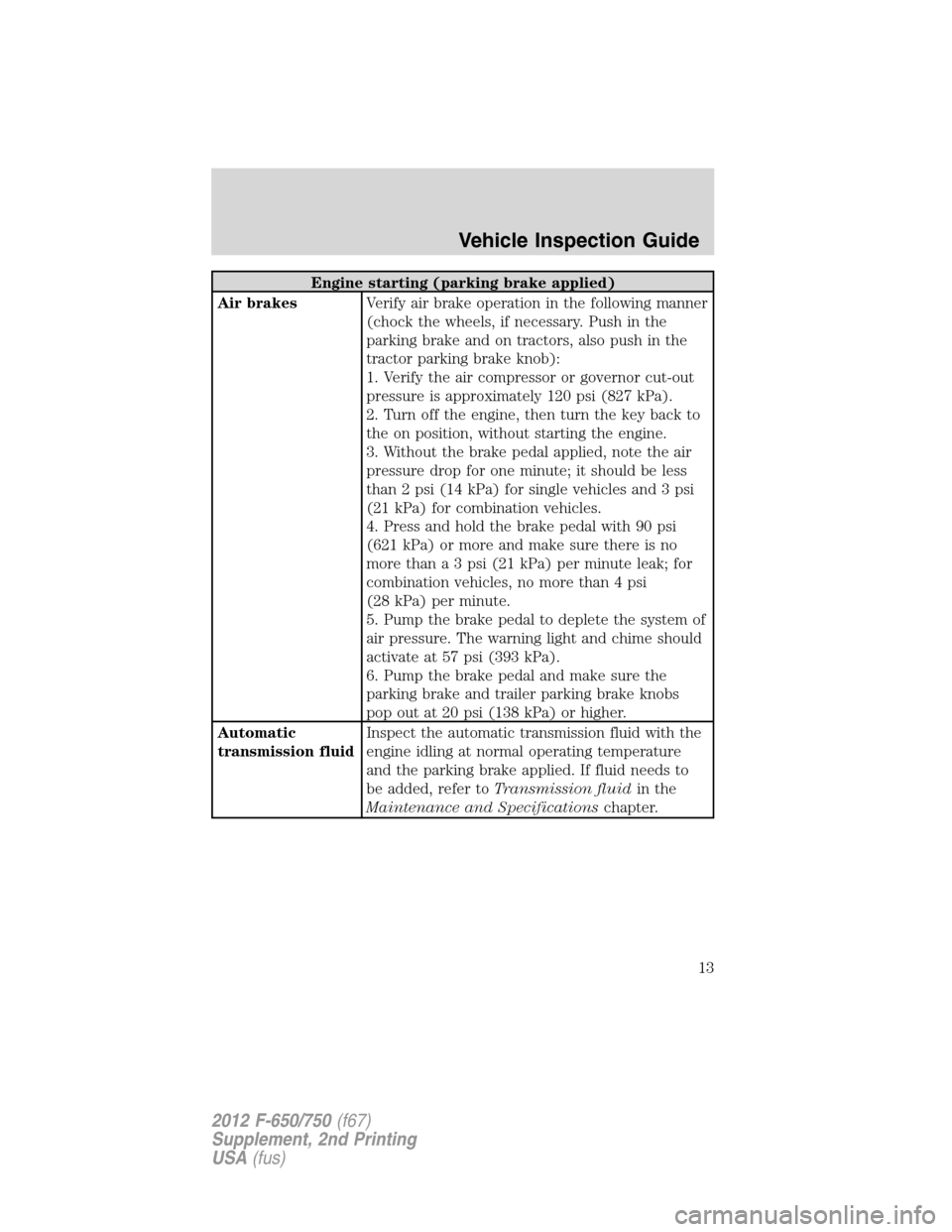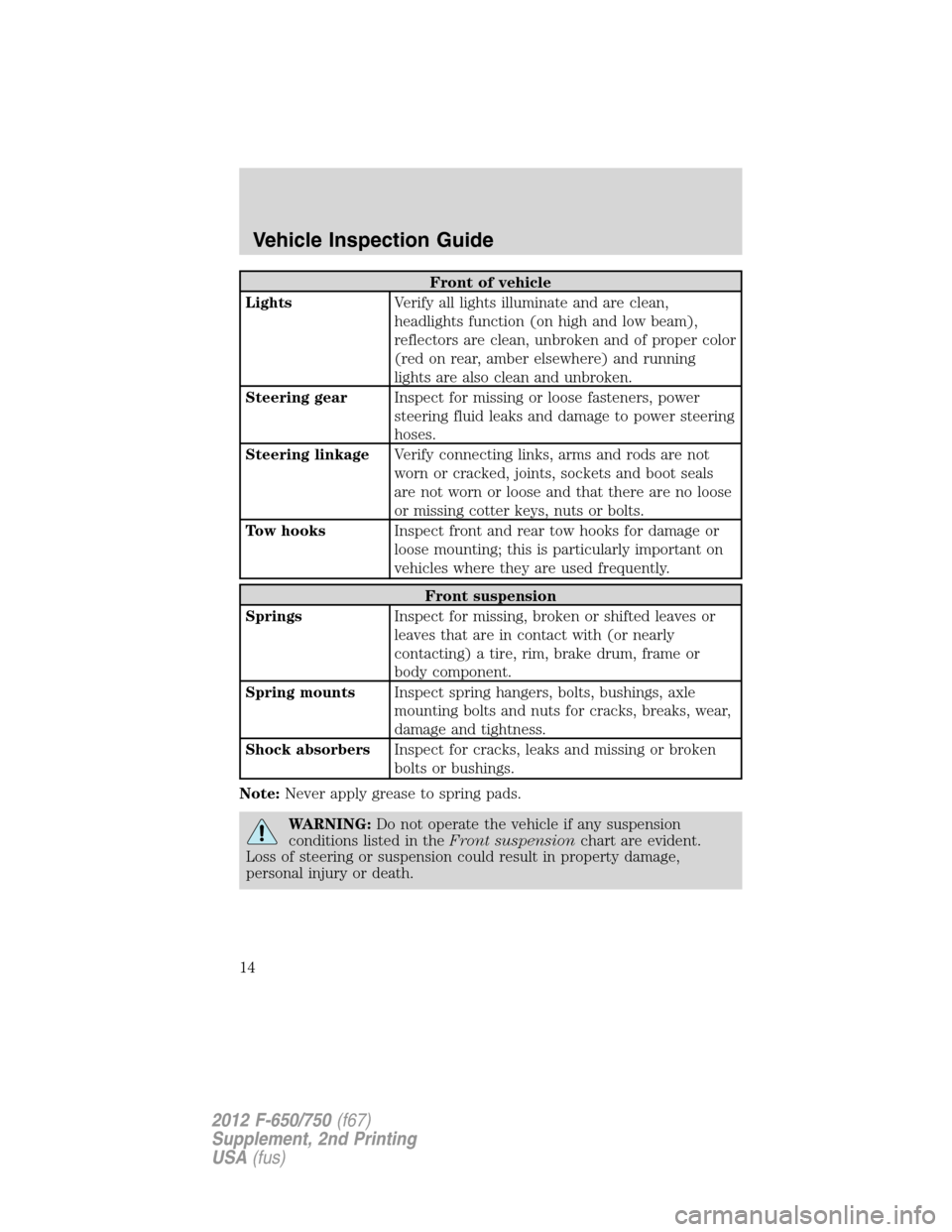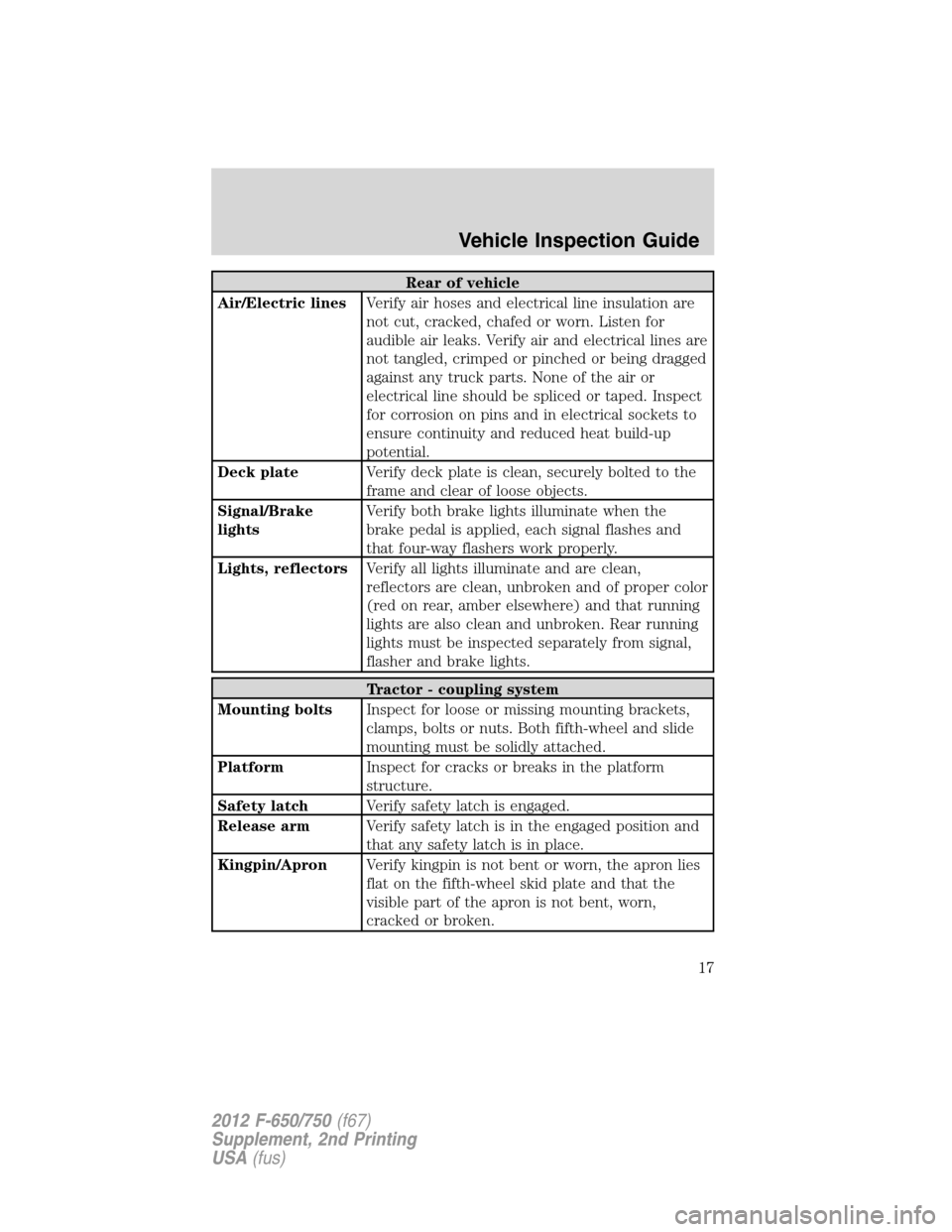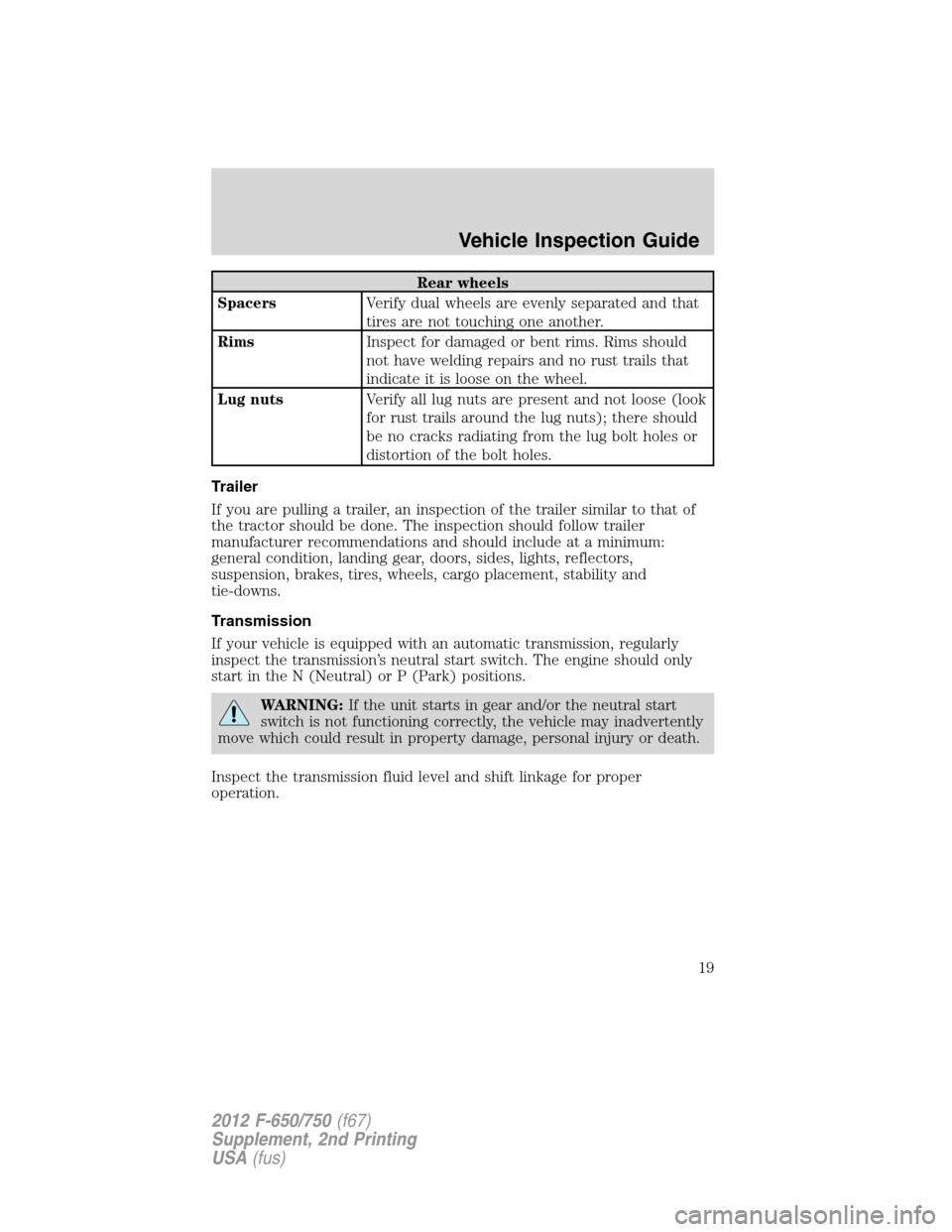2012 FORD F650 brake light
[x] Cancel search: brake lightPage 8 of 306

These are some of the symbols you may see on your vehicle.
Vehicle Symbol Glossary
Safety Alert
See Owner’s Guide
Fasten Safety BeltAirbag - Front
Airbag - SideChild Seat Lower
Anchor
Child Seat Tether
AnchorBrake System
Anti-Lock Brake SystemParking Brake System
Brake Fluid -
Non-Petroleum BasedParking Aid System
Stability Control SystemSpeed Control
Master Lighting SwitchHazard Warning Flasher
Fog Lamps-FrontFuse Compartment
Fuel Pump ResetWindshield Wash/Wipe
Windshield
Defrost/DemistRear Window
Defrost/Demist
Introduction
8
2012 F-650/750(f67)
Supplement, 2nd Printing
USA(fus)
Page 11 of 306

WARNING:Exercise great caution when working on vehicle
equipped with an automatic fan clutch. The fan starts in motion
only after the engine coolant reaches a predetermined temperature or
the refrigerant pressure (if equipped with air conditioning) reaches a
predetermined setting. The fan starts at this point with no advance
warning. Never reach near, or permit objects to protrude into, the fan
blade radius while the engine is running as this could result in vehicle
damage, personal injury or death.
Engine starting (parking brake applied)
Safety/Emergency
equipmentBefore entering the cab, verify that the vehicle is
equipped with spare electrical fuses (if used),
three red reflective triangles, a properly charged
and rated fire extinguisher and wheel chocks.
Walk around the vehicle and verify all steps and
grab handles, inside and out as well as behind,
are tight and clean. Use extreme caution and a
three-point stance at all times. Inspect door
latches for positive closing, latching and locking.
Starting the
engineSet the parking brake, press the clutch (if
equipped with a manual transmission) and verify
the transmission is in neutral. Vehicles equipped
with an automatic transmission should be in N
(Neutral) or P (Park) (if equipped with a park
position).
Diesel engine:Turn the key to the on position;
when the
light in the instrument cluster
turns off, turn the key to start.
Gas engine:Turn the key to start, then release
it as soon as the engine starts.
Oil pressureVerify engine oil pressure builds to normal
operating range.
Vehicle Inspection Guide
11
2012 F-650/750(f67)
Supplement, 2nd Printing
USA(fus)
Page 12 of 306

Engine starting (parking brake applied)
Air chime (if
equipped with air
compressor)The low air pressure warning chime should sound
immediately after the engine starts but before the
compressor has built-up pressure. The chime
should stop when the air pressure reaches 70 psi
(483 kPa) (or more). Let the air pressure build
to governed cut-out pressure, which should occur
between 115–130 psi (793–896 kPa).
AcceleratorPress the accelerator and verify that it operates
smoothly, without any binding or irregular feel.
Release the pedal and verify the engine returns
to idle speed immediately.
VoltmeterInspect the gauge (diesel engine) or indicator
light (gasoline engine) to verify the alternator is
charging.
Steering linkage
free playInspect for excessive free play in the steering
linkages. The steering wheel should have less
than 2 inches (5 cm) of free play at its rim.
Full Power
Hydraulic brake
inspectionPump the brake pedal several times with the
ignition in the off or run position; the
motor/pumps can be heard momentarily
replenishing the accumulators.
Parking brakeVerify the parking brake holds the vehicle by
gently trying to pull forward with the parking
brake applied.
Vehicle Inspection Guide
12
2012 F-650/750(f67)
Supplement, 2nd Printing
USA(fus)
Page 13 of 306

Engine starting (parking brake applied)
Air brakesVerify air brake operation in the following manner
(chock the wheels, if necessary. Push in the
parking brake and on tractors, also push in the
tractor parking brake knob):
1. Verify the air compressor or governor cut-out
pressure is approximately 120 psi (827 kPa).
2. Turn off the engine, then turn the key back to
the on position, without starting the engine.
3. Without the brake pedal applied, note the air
pressure drop for one minute; it should be less
than 2 psi (14 kPa) for single vehicles and 3 psi
(21 kPa) for combination vehicles.
4. Press and hold the brake pedal with 90 psi
(621 kPa) or more and make sure there is no
more than a 3 psi (21 kPa) per minute leak; for
combination vehicles, no more than 4 psi
(28 kPa) per minute.
5. Pump the brake pedal to deplete the system of
air pressure. The warning light and chime should
activate at 57 psi (393 kPa).
6. Pump the brake pedal and make sure the
parking brake and trailer parking brake knobs
pop out at 20 psi (138 kPa) or higher.
Automatic
transmission fluidInspect the automatic transmission fluid with the
engine idling at normal operating temperature
and the parking brake applied. If fluid needs to
be added, refer toTransmission fluidin the
Maintenance and Specificationschapter.
Vehicle Inspection Guide
13
2012 F-650/750(f67)
Supplement, 2nd Printing
USA(fus)
Page 14 of 306

Front of vehicle
LightsVerify all lights illuminate and are clean,
headlights function (on high and low beam),
reflectors are clean, unbroken and of proper color
(red on rear, amber elsewhere) and running
lights are also clean and unbroken.
Steering gearInspect for missing or loose fasteners, power
steering fluid leaks and damage to power steering
hoses.
Steering linkageVerify connecting links, arms and rods are not
worn or cracked, joints, sockets and boot seals
are not worn or loose and that there are no loose
or missing cotter keys, nuts or bolts.
Tow hooksInspect front and rear tow hooks for damage or
loose mounting; this is particularly important on
vehicles where they are used frequently.
Front suspension
SpringsInspect for missing, broken or shifted leaves or
leaves that are in contact with (or nearly
contacting) a tire, rim, brake drum, frame or
body component.
Spring mountsInspect spring hangers, bolts, bushings, axle
mounting bolts and nuts for cracks, breaks, wear,
damage and tightness.
Shock absorbersInspect for cracks, leaks and missing or broken
bolts or bushings.
Note:Never apply grease to spring pads.
WARNING:Do not operate the vehicle if any suspension
conditions listed in theFront suspensionchart are evident.
Loss of steering or suspension could result in property damage,
personal injury or death.
Vehicle Inspection Guide
14
2012 F-650/750(f67)
Supplement, 2nd Printing
USA(fus)
Page 17 of 306

Rear of vehicle
Air/Electric linesVerify air hoses and electrical line insulation are
not cut, cracked, chafed or worn. Listen for
audible air leaks. Verify air and electrical lines are
not tangled, crimped or pinched or being dragged
against any truck parts. None of the air or
electrical line should be spliced or taped. Inspect
for corrosion on pins and in electrical sockets to
ensure continuity and reduced heat build-up
potential.
Deck plateVerify deck plate is clean, securely bolted to the
frame and clear of loose objects.
Signal/Brake
lightsVerify both brake lights illuminate when the
brake pedal is applied, each signal flashes and
that four-way flashers work properly.
Lights, reflectorsVerify all lights illuminate and are clean,
reflectors are clean, unbroken and of proper color
(red on rear, amber elsewhere) and that running
lights are also clean and unbroken. Rear running
lights must be inspected separately from signal,
flasher and brake lights.
Tractor - coupling system
Mounting boltsInspect for loose or missing mounting brackets,
clamps, bolts or nuts. Both fifth-wheel and slide
mounting must be solidly attached.
PlatformInspect for cracks or breaks in the platform
structure.
Safety latchVerify safety latch is engaged.
Release armVerify safety latch is in the engaged position and
that any safety latch is in place.
Kingpin/ApronVerify kingpin is not bent or worn, the apron lies
flat on the fifth-wheel skid plate and that the
visible part of the apron is not bent, worn,
cracked or broken.
Vehicle Inspection Guide
17
2012 F-650/750(f67)
Supplement, 2nd Printing
USA(fus)
Page 19 of 306

Rear wheels
SpacersVerify dual wheels are evenly separated and that
tires are not touching one another.
RimsInspect for damaged or bent rims. Rims should
not have welding repairs and no rust trails that
indicate it is loose on the wheel.
Lug nutsVerify all lug nuts are present and not loose (look
for rust trails around the lug nuts); there should
be no cracks radiating from the lug bolt holes or
distortion of the bolt holes.
Trailer
If you are pulling a trailer, an inspection of the trailer similar to that of
the tractor should be done. The inspection should follow trailer
manufacturer recommendations and should include at a minimum:
general condition, landing gear, doors, sides, lights, reflectors,
suspension, brakes, tires, wheels, cargo placement, stability and
tie-downs.
Transmission
If your vehicle is equipped with an automatic transmission, regularly
inspect the transmission’s neutral start switch. The engine should only
start in the N (Neutral) or P (Park) positions.
WARNING:If the unit starts in gear and/or the neutral start
switch is not functioning correctly, the vehicle may inadvertently
move which could result in property damage, personal injury or death.
Inspect the transmission fluid level and shift linkage for proper
operation.
Vehicle Inspection Guide
19
2012 F-650/750(f67)
Supplement, 2nd Printing
USA(fus)
Page 21 of 306

when you start your vehicle to make sure the bulb works. If any light
remains on after starting the vehicle, refer to the respective system
warning light for additional information.
Note:Some warning lights are
reconfigurable telltale (RTT)
indicator lights and illuminate in the
message center. These lights
function the same as the other
warning lights.
Anti-lock brake system:If the
ABS light stays illuminated or
continues to flash, a malfunction has
been detected, have the system
serviced immediately by your
authorized dealer. Normal braking is still functional unless the brake
warning light is also illuminated.
Brake system warning light:To
confirm the brake system warning
light is functional, it momentarily
illuminates when the ignition is
turned to the on position when the
engine is not running, or in a
position between on and start, or by
applying the parking brake when the
ignition is turned to the on position.
If the brake system warning light does not illuminate at this time, seek
service immediately from your authorized dealer. Illumination after
releasing the parking brake indicates low brake fluid level and the brake
system should be inspected immediately by your authorized dealer.
WARNING:Driving a vehicle with the brake system warning
light on is dangerous. A significant decrease in braking
performance may occur. It takes you longer to stop the vehicle. Have
the vehicle checked by your authorized dealer. Driving extended
distances with the parking brake engaged can cause brake failure and
the risk of personal injury.
ABS
Instrument Cluster
21
2012 F-650/750(f67)
Supplement, 2nd Printing
USA(fus)